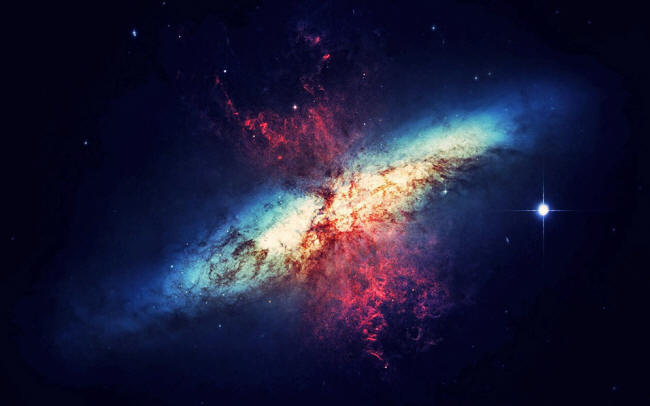|

by Laura Arenschield
The Ohio
State University
October 31, 2019
from
PHYS Website

Credit: CC0 Public Domain
Black holes are an important part
of how astrophysicists make sense of the universe - so important
that scientists have been trying to build a census of all the black
holes in
the Milky Way galaxy.
But new research shows that their search might have been missing an
entire class of black holes that they didn't know existed.
In a study (A
Noninteracting Low-Mass Black Hole - Giant Star Binary System)
published today in the journal Science, astronomers offer a
new way to search for black holes, and show that it is possible
there is a class of black holes smaller than the smallest known
black holes in the universe.
"We're showing this
hint that there is another population out there that we have yet
to really probe in the search for black holes," said Todd
Thompson, a professor of astronomy at The Ohio State University
and lead author of the study.
"People are trying to understand supernova explosions, how
supermassive black stars explode, how the elements were formed
in supermassive stars.
So if we could reveal
a new population of black holes, it would tell us more about
which stars explode, which don't, which form black holes, which
form neutron stars.
It opens up a new
area of study."
Imagine a census of a
city that only counted people 5'9" and taller - and imagine that the
census takers didn't even know that people shorter than 5'9"
existed.
Data from that census
would be incomplete, providing an inaccurate picture of the
population. That is essentially what has been happening in the
search for black holes, Todd Thompson said.
Astronomers have long been searching for black holes, which have
gravitational pulls so fierce that nothing - not matter, not
radiation - can escape.
Black holes form when
some stars die, shrink into themselves, and explode. Astronomers
have also been looking for
neutron stars:
small, dense stars
that form when some stars die and collapse.
Both could hold
interesting information about the elements on Earth and about how
stars live and die.
But in order to uncover
that information, astronomers first have to figure out where the
black holes are. And to figure out where the black holes are, they
need to know what they are looking for.
One clue:
Black holes often
exist in something called a
binary system.
This simply means that
two stars are close enough to one another to be locked together by
gravity in a mutual orbit around one another.
When one of those stars
dies, the other can remain, still orbiting the space where the dead
star - now a black hole or neutron star - once lived, and where a
black hole or neutron star has formed.
For years, the black holes scientists knew about were all between
approximately five and 15 times the mass of the sun.
The known neutron stars
are generally no bigger than about 2.1 times the mass of the sun -
if they were above 2.5 times the sun's mass, they would collapse to
a black hole
But in the summer of 2017, a survey called
LIGO - the Laser Interferometer
Gravitational-Wave Observatory - saw two black holes merging
together in a galaxy about 1.8 billion light years away.
One of those black holes
was about 31 times the mass of the sun; the other about 25 times the
mass of the sun.
"Immediately,
everyone was like 'wow,' because it was such a spectacular
thing," Thompson said.
"Not only because it
proved that LIGO worked, but because the masses were huge. Black
holes that size are a big deal - we hadn't seen them before."
Thompson and other
astrophysicists had long suspected that black holes might come in
sizes outside the known range, and LIGO's discovery proved that
black holes could be larger.
But there remained a
window of size between the biggest neutron stars and the
smallest black holes.
Thompson decided to see if he could solve that mystery.
He and other scientists began combing through data from
APOGEE, the Apache Point
Observatory Galactic Evolution Experiment, which collected light
spectra from around 100,000 stars across the Milky Way.
The spectra, Thompson
realized, could show whether a star might be orbiting around another
object:
Changes in spectra -
a shift toward bluer wavelengths, for example, followed by a
shift to redder wavelengths - could show that a star was
orbiting an unseen companion.
Thompson began combing
through the data, looking for stars that showed that change,
indicating that they might be orbiting a black hole.
Then, he narrowed the APOGEE data to 200 stars that might be most
interesting.
He gave the data to a
graduate research associate at Ohio State, Tharindu Jayasinghe,
who compiled thousands of images of each potential binary system
from ASAS-SN, the All-Sky Automated Survey for Supernovae. (ASAS-SN
has found some 1,000
supernovae, and is run out of Ohio
State.)
Their data crunching found a giant red star that appeared to be
orbiting something, but that something, based on their calculations,
was likely much smaller than the known black holes in the Milky Way,
but way bigger than most known
neutron stars.
After more calculations and additional data from the Tillinghast
Reflector Echelle Spectrograph (TRES)
and the
Gaia satellite, they realized
they had found a low-mass black hole, likely about 3.3 times
the mass of the sun.
"What we've done here
is come up with a new way to search for black holes, but we've
also potentially identified one of the first of a new class of
low-mass black holes that astronomers hadn't previously known
about." Thompson said.
"The masses of things
tell us about their formation and evolution, and they tell us
about their nature."
More
information
|


